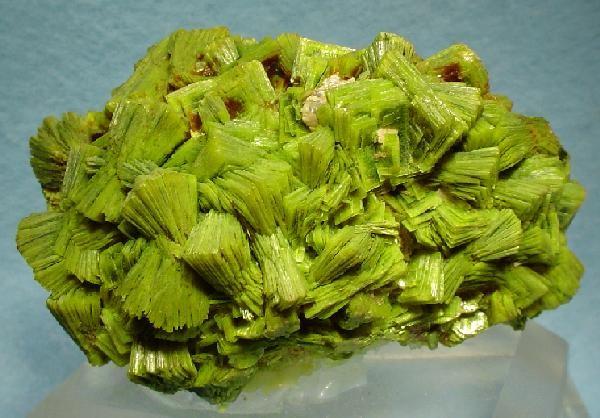


Autunite is a phosphate mineral that formula is calcium uranium phosphate (Ca (UO2)2(PO4)2·10–12H2O) and It is harness of 2 – 2, 5.A popular collector’s mineral. Greenish or lemon yellow in color, autunite specimens fluoresce green under ultraviolet light. Autunite crystallizes in the orthorhombic system and often occurs as tabular square crystals, commonly in small crusts or in fan-like masses. Due to the moderate uranium content of 48.27% it is radioactive and also used as uranium ore. Coarse groups are found, but scaly coatings are more common. It is also found as crusts with crystals standing on edge, giving a serrated appearance. Named after Autun, France, where this mineral was discovered. It is formed in the oxidation zones of uranium ore bodies as an alteration product of uraniniteand other uranium-bearing minerals. It also occurs in hydrothermal veins and in pegmatites. Since autunite contains uranium and is radioactive, it must be stored carefully and handled as little as possible. When mildly heated, tetragonal autunite dehydrates into orthorhombic meta-autunite. Most museum and collector specimens of autunite have been converted to meta-autunite. A moist atmosphere helps prevent dehydration.
Name: For Autun, France, near to which the first specimens to be analyzed were collected.
Association: Meta-autunite, torbernite, phosphuranylite, saleeite, uranophane, uranophane-beta, sabugalite.
Mineral Group: Autunite group.
Morphology: Crystals thin to thick tabular {001}, and with a rectangular or octagonal outline. Subparallel growths common; foliated or scaly aggregates, crusts.
Type Material: Natural History Museum, Paris, France, H6307.
Chemical Properties
| Chemical Classification | Phosphate minerals |
| Formula | Ca(UO2)2(PO4)2 · 11H2O |
Autunite Physical Properties
| Color | Yellow, greenish-yellow, pale green; dark green, greenish black. |
| Streak | Pale yellow |
| Luster | Sub-Vitreous, Resinous, Waxy, Pearly |
| Cleavage | Perfect Perfect on {001}, indistinct on {100} |
| Diaphaneity | Transparent, Translucent |
| Mohs Hardness | 2 – 2,5 |
| Crystal System | Orthorhombic |
| Fracture | Micaceous |
| Density | 3.05 – 3.2 g/cm3 (Measured) 3.14 g/cm3 (Calculated) |
| Tenacity | Sectile |
Autunite Optical Properties
| Optical Extinction | Z=c, Y={110} |
| Color / Pleochroism | Visible |
| 2V: | Measured: 10° to 53° |
| RI values: | nα = 1.553 – 1.555 nβ = 1.575 nγ = 1.577 – 1.578 nω = 1.575 nε = 1.572 |
| Twinning | Rare interpenetrant twinning on {110}. |
| Optic Sign | Biaxial (-) |
| Birefringence | δ = 0.003 |
| Relief | Low |
| Dispersion: | r > v strong |
Occurrence of Autunite
A secondary mineral derived from primary uranium-bearing minerals under oxidizing conditions, in hydrothermal veins, granite pegmatites, etc
Uses Area
This radioactive mineral is a very rich source of uranium containing about 48.27% uranium. Therefore, it is used as uranium ore in various industries. It is also used as a mineral sample.
Autunite Distribution
Widespread, many minor localities, but few for outstanding specimens.
- In France, at LOuche dJau, Saint-Symphorien-de-Marmagne, and the Les Oudots mine, Autun district, Saone-et-Loire; from the Margnac mine, Compreignac, Haute-Vienne; large crystals from the Gagnol mine, Lachaux, Puy-de-Dome.
- From Sabugal, Urgeirica, and elsewhere in Portugal.
- At Peveragno, near Cuneo, Piedmont, Italy.
- Large crystals from Bergen, Vogtland, Germany.
- From a number of localities in Cornwall, England.
- Fine groups from the Dahl (Daybreak) mine, near Mt. Spokane, east of Elk, Spokane Co., Washington, USA.
- At Malacacheta, Minas Gerais, Brazil.
- Large crystals from Mt. Painter, Flinders Ranges, South Australia.
References
- Bonewitz, R. (2012). Rocks and minerals. 2nd ed. London: DK Publishing.
- Handbookofmineralogy.org. (2019). Handbook of Mineralogy. [online] Available at: http://www.handbookofmineralogy.org [Accessed 4 Mar. 2019].
- Mindat.org. (2019): Mineral information, data and localities.. [online] Available at: https://www.mindat.org/ [Accessed. 2019].




































